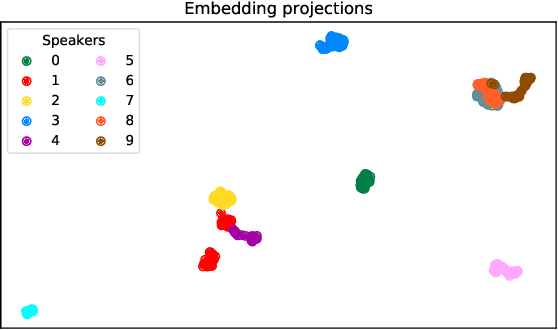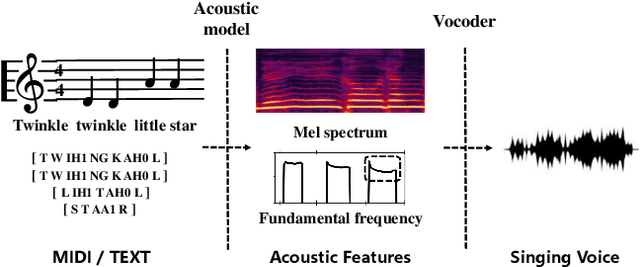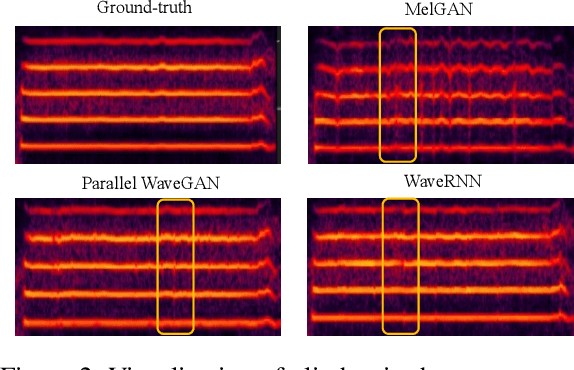Feiyang Chen
Gemini Embedding: Generalizable Embeddings from Gemini
Mar 10, 2025Abstract:In this report, we introduce Gemini Embedding, a state-of-the-art embedding model leveraging the power of Gemini, Google's most capable large language model. Capitalizing on Gemini's inherent multilingual and code understanding capabilities, Gemini Embedding produces highly generalizable embeddings for text spanning numerous languages and textual modalities. The representations generated by Gemini Embedding can be precomputed and applied to a variety of downstream tasks including classification, similarity, clustering, ranking, and retrieval. Evaluated on the Massive Multilingual Text Embedding Benchmark (MMTEB), which includes over one hundred tasks across 250+ languages, Gemini Embedding substantially outperforms prior state-of-the-art models, demonstrating considerable improvements in embedding quality. Achieving state-of-the-art performance across MMTEB's multilingual, English, and code benchmarks, our unified model demonstrates strong capabilities across a broad selection of tasks and surpasses specialized domain-specific models.
AttentionEngine: A Versatile Framework for Efficient Attention Mechanisms on Diverse Hardware Platforms
Feb 21, 2025Abstract:Transformers and large language models (LLMs) have revolutionized machine learning, with attention mechanisms at the core of their success. As the landscape of attention variants expands, so too do the challenges of optimizing their performance, particularly across different hardware platforms. Current optimization strategies are often narrowly focused, requiring extensive manual intervention to accommodate changes in model configurations or hardware environments. In this paper, we introduce AttentionEngine, a comprehensive framework designed to streamline the optimization of attention mechanisms across heterogeneous hardware backends. By decomposing attention computation into modular operations with customizable components, AttentionEngine enables flexible adaptation to diverse algorithmic requirements. The framework further automates kernel optimization through a combination of programmable templates and a robust cross-platform scheduling strategy. Empirical results reveal performance gains of up to 10x on configurations beyond the reach of existing methods. AttentionEngine offers a scalable, efficient foundation for developing and deploying attention mechanisms with minimal manual tuning. Our code has been open-sourced and is available at https://github.com/microsoft/AttentionEngine.
Sigma: Differential Rescaling of Query, Key and Value for Efficient Language Models
Jan 23, 2025



Abstract:We introduce Sigma, an efficient large language model specialized for the system domain, empowered by a novel architecture including DiffQKV attention, and pre-trained on our meticulously collected system domain data. DiffQKV attention significantly enhances the inference efficiency of Sigma by optimizing the Query (Q), Key (K), and Value (V) components in the attention mechanism differentially, based on their varying impacts on the model performance and efficiency indicators. Specifically, we (1) conduct extensive experiments that demonstrate the model's varying sensitivity to the compression of K and V components, leading to the development of differentially compressed KV, and (2) propose augmented Q to expand the Q head dimension, which enhances the model's representation capacity with minimal impacts on the inference speed. Rigorous theoretical and empirical analyses reveal that DiffQKV attention significantly enhances efficiency, achieving up to a 33.36% improvement in inference speed over the conventional grouped-query attention (GQA) in long-context scenarios. We pre-train Sigma on 6T tokens from various sources, including 19.5B system domain data that we carefully collect and 1T tokens of synthesized and rewritten data. In general domains, Sigma achieves comparable performance to other state-of-arts models. In the system domain, we introduce the first comprehensive benchmark AIMicius, where Sigma demonstrates remarkable performance across all tasks, significantly outperforming GPT-4 with an absolute improvement up to 52.5%.
MSceneSpeech: A Multi-Scene Speech Dataset For Expressive Speech Synthesis
Jul 19, 2024



Abstract:We introduce an open source high-quality Mandarin TTS dataset MSceneSpeech (Multiple Scene Speech Dataset), which is intended to provide resources for expressive speech synthesis. MSceneSpeech comprises numerous audio recordings and texts performed and recorded according to daily life scenarios. Each scenario includes multiple speakers and a diverse range of prosodic styles, making it suitable for speech synthesis that entails multi-speaker style and prosody modeling. We have established a robust baseline, through the prompting mechanism, that can effectively synthesize speech characterized by both user-specific timbre and scene-specific prosody with arbitrary text input. The open source MSceneSpeech Dataset and audio samples of our baseline are available at https://speechai-demo.github.io/MSceneSpeech/.
Werewolf Arena: A Case Study in LLM Evaluation via Social Deduction
Jul 18, 2024Abstract:This paper introduces Werewolf Arena, a novel framework for evaluating large language models (LLMs) through the lens of the classic social deduction game, Werewolf. In Werewolf Arena, LLMs compete against each other, navigating the game's complex dynamics of deception, deduction, and persuasion. The framework introduces a dynamic turn-taking system based on bidding, mirroring real-world discussions where individuals strategically choose when to speak. We demonstrate the framework's utility through an arena-style tournament featuring Gemini and GPT models. Our results reveal distinct strengths and weaknesses in the models' strategic reasoning and communication. These findings highlight Werewolf Arena's potential as a challenging and scalable LLM benchmark.
Comprehensive Survey of Model Compression and Speed up for Vision Transformers
Apr 16, 2024Abstract:Vision Transformers (ViT) have marked a paradigm shift in computer vision, outperforming state-of-the-art models across diverse tasks. However, their practical deployment is hampered by high computational and memory demands. This study addresses the challenge by evaluating four primary model compression techniques: quantization, low-rank approximation, knowledge distillation, and pruning. We methodically analyze and compare the efficacy of these techniques and their combinations in optimizing ViTs for resource-constrained environments. Our comprehensive experimental evaluation demonstrates that these methods facilitate a balanced compromise between model accuracy and computational efficiency, paving the way for wider application in edge computing devices.
StyleSinger: Style Transfer for Out-of-Domain Singing Voice Synthesis
Jan 02, 2024Abstract:Style transfer for out-of-domain (OOD) singing voice synthesis (SVS) focuses on generating high-quality singing voices with unseen styles (such as timbre, emotion, pronunciation, and articulation skills) derived from reference singing voice samples. However, the endeavor to model the intricate nuances of singing voice styles is an arduous task, as singing voices possess a remarkable degree of expressiveness. Moreover, existing SVS methods encounter a decline in the quality of synthesized singing voices in OOD scenarios, as they rest upon the assumption that the target vocal attributes are discernible during the training phase. To overcome these challenges, we propose StyleSinger, the first singing voice synthesis model for zero-shot style transfer of out-of-domain reference singing voice samples. StyleSinger incorporates two critical approaches for enhanced effectiveness: 1) the Residual Style Adaptor (RSA) which employs a residual quantization module to capture diverse style characteristics in singing voices, and 2) the Uncertainty Modeling Layer Normalization (UMLN) to perturb the style attributes within the content representation during the training phase and thus improve the model generalization. Our extensive evaluations in zero-shot style transfer undeniably establish that StyleSinger outperforms baseline models in both audio quality and similarity to the reference singing voice samples. Access to singing voice samples can be found at https://stylesinger.github.io/.
TextrolSpeech: A Text Style Control Speech Corpus With Codec Language Text-to-Speech Models
Aug 28, 2023Abstract:Recently, there has been a growing interest in the field of controllable Text-to-Speech (TTS). While previous studies have relied on users providing specific style factor values based on acoustic knowledge or selecting reference speeches that meet certain requirements, generating speech solely from natural text prompts has emerged as a new challenge for researchers. This challenge arises due to the scarcity of high-quality speech datasets with natural text style prompt and the absence of advanced text-controllable TTS models. In light of this, 1) we propose TextrolSpeech, which is the first large-scale speech emotion dataset annotated with rich text attributes. The dataset comprises 236,220 pairs of style prompt in natural text descriptions with five style factors and corresponding speech samples. Through iterative experimentation, we introduce a multi-stage prompt programming approach that effectively utilizes the GPT model for generating natural style descriptions in large volumes. 2) Furthermore, to address the need for generating audio with greater style diversity, we propose an efficient architecture called Salle. This architecture treats text controllable TTS as a language model task, utilizing audio codec codes as an intermediate representation to replace the conventional mel-spectrogram. Finally, we successfully demonstrate the ability of the proposed model by showing a comparable performance in the controllable TTS task. Audio samples are available at https://sall-e.github.io/
Multi-Singer: Fast Multi-Singer Singing Voice Vocoder With A Large-Scale Corpus
Dec 20, 2021



Abstract:High-fidelity multi-singer singing voice synthesis is challenging for neural vocoder due to the singing voice data shortage, limited singer generalization, and large computational cost. Existing open corpora could not meet requirements for high-fidelity singing voice synthesis because of the scale and quality weaknesses. Previous vocoders have difficulty in multi-singer modeling, and a distinct degradation emerges when conducting unseen singer singing voice generation. To accelerate singing voice researches in the community, we release a large-scale, multi-singer Chinese singing voice dataset OpenSinger. To tackle the difficulty in unseen singer modeling, we propose Multi-Singer, a fast multi-singer vocoder with generative adversarial networks. Specifically, 1) Multi-Singer uses a multi-band generator to speed up both training and inference procedure. 2) to capture and rebuild singer identity from the acoustic feature (i.e., mel-spectrogram), Multi-Singer adopts a singer conditional discriminator and conditional adversarial training objective. 3) to supervise the reconstruction of singer identity in the spectrum envelopes in frequency domain, we propose an auxiliary singer perceptual loss. The joint training approach effectively works in GANs for multi-singer voices modeling. Experimental results verify the effectiveness of OpenSinger and show that Multi-Singer improves unseen singer singing voices modeling in both speed and quality over previous methods. The further experiment proves that combined with FastSpeech 2 as the acoustic model, Multi-Singer achieves strong robustness in the multi-singer singing voice synthesis pipeline. Samples are available at https://Multi-Singer.github.io/
SingGAN: Generative Adversarial Network For High-Fidelity Singing Voice Generation
Oct 26, 2021



Abstract:High-fidelity singing voice synthesis is challenging for neural vocoders due to extremely long continuous pronunciation, high sampling rate and strong expressiveness. Existing neural vocoders designed for text-to-speech cannot directly be applied to singing voice synthesis because they result in glitches in the generated spectrogram and poor high-frequency reconstruction. To tackle the difficulty of singing modeling, in this paper, we propose SingGAN, a singing voice vocoder with generative adversarial network. Specifically, 1) SingGAN uses source excitation to alleviate the glitch problem in the spectrogram; and 2) SingGAN adopts multi-band discriminators and introduces frequency-domain loss and sub-band feature matching loss to supervise high-frequency reconstruction. To our knowledge, SingGAN is the first vocoder designed towards high-fidelity multi-speaker singing voice synthesis. Experimental results show that SingGAN synthesizes singing voices with much higher quality (0.41 MOS gains) over the previous method. Further experiments show that combined with FastSpeech~2 as an acoustic model, SingGAN achieves high robustness in the singing voice synthesis pipeline and also performs well in speech synthesis.
 Add to Chrome
Add to Chrome Add to Firefox
Add to Firefox Add to Edge
Add to Edge